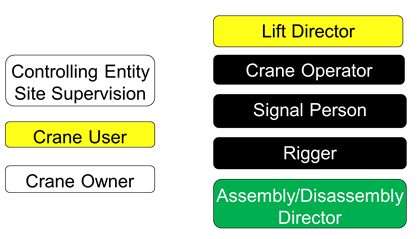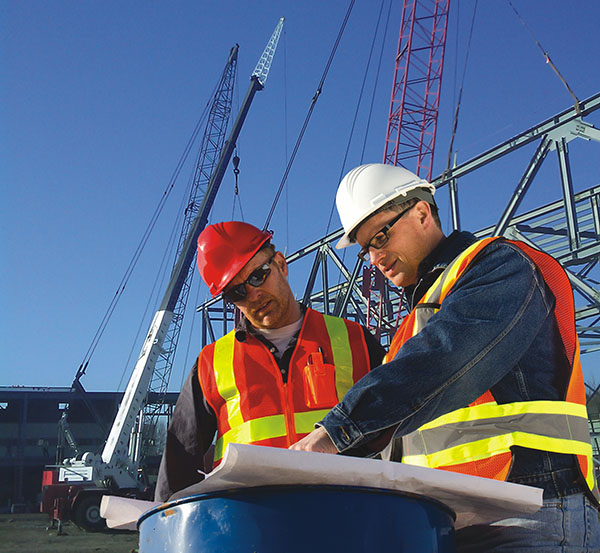Third in a series of related articles reviewing each of the roles that have been identified when working with cranes, explaining their responsibilities, defining their training requirements, and outlining their documentation requirements.
June 2021— As stated in our previous articles, the roles on the left side are roles that do not have any requirements listed for qualifications (e.g. competent, certified, or qualified). The roles on the right side, however, do have prescribed qualifications and responsibilities.
As stated in our previous articles, the roles on the left side are roles that do not have any requirements listed for qualifications (e.g. competent, certified, or qualified). The roles on the right side, however, do have prescribed qualifications and responsibilities.
The role of
Lift Director has become a critical role to identify on the jobsite. Lift Directors are assigned by the Site Supervisor (see previous article for responsibilities of Site Supervisors). This means that if there is confusion related to who is performing the role of Lift Director, the Site Supervisor is usually cited. We have also found that enforcement actions often begin with asking the rigger and signal person to identify the Lift Director.
As ASME was the creator, the role of Lift Director applies to all industries. However, despite the requirements being published in 2007, many organizations that use cranes are unfamiliar with the term or the allocation of responsibilities.
In response, in OSHA’s compliance directive of 2014, the term “Lift Director” is used 41 times. OSHA has also cited companies for failure to “designate a competent lift director” as early as 2013. Today, more and more organizations are identifying the Lift Director by means of a uniquely colored vest or hardhat as well as requiring pre-lift meeting logs that identify the person who is filling the role of Lift Director.
Under ASME, the Lift Director is required to be a qualified individual. Qualified “means a person who, by possession of a recognized degree, certificate, or professional standing, or who by extensive knowledge, training and experience, successfully demonstrated the ability to solve/resolve problems relating to the subject matter, the work, or the project.” Therein lies the issue. Site supervisors must have some means by which to show that the Lift Director successfully demonstrated the ability to solve or resolve Lift Director problems.
The areas of Lift Director responsibilities help define the content of what the Lift Director should know. They include:
- Being present at the jobsite during lifting operations.
- Ensuring the area needed for crane operations has been prepared before operations commence.
- Ensuring personnel involved understand their responsibilities, assigned duties, and associated hazards.
- Addressing safety concerns and being responsible if they overrule concerns and direct operations to continue.
- Appointing the signal person(s) and ensuring they are qualified.
- Ensuring compliance when working near power lines or lifting personnel.
- Ensuring the load rigging is performed by a competent rigger.
- Ensuring precautions are implemented in special lifting operations.

Today, more and more organizations are identifying the Lift Director by means of a uniquely colored vest or hardhat as well as requiring pre-lift meeting logs that identify the person who is filling the role of Lift Director.
There are two areas that we should dive a little deeper into as they tend to contain the most questions.
First, the Lift Director does not have to watch every single lift. ASME changed the language in 2018 to remove the requirement that the Lift Director needed to ensure that the load was balanced. This responsibility was moved to the Rigger. Lift Directors can assign rigging of the load and load parameters to a crew and be alerted should the parameters change. However, on any critical lift, the qualified Lift Director should play more of a visible role.
Often the question comes up, “Isn’t the operator the Lift Director?” The short answer is “no.” The Lift Director has the responsibility to address the safety concerns and they are responsible if they overrule the concerns and direct operations to continue. This paramount duty and responsibility rests with the person who the Site Supervisor identified and qualified to direct the crews—the Lift Director.
Lift Directors do not have to be experts on the crane at the site (they rely on the Crane Operator for crane and load chart information); however, the Lift Director takes all of the factors into account before letting the lift proceed.
There are numerous courses and training classes available for Lift Director. However, training should be validated through certification to ensure its effectiveness. NCCCO is proud to offer the only accredited certification for Lift Director available in the industry. For more information, please go to www.nccco.org/LD.
By Thom Sicklesteel, CEO of the National Commission for the Certification of Crane Operators (NCCCO), a voting member of ASME B30.5, and an alternate on B30.
View the other articles in this series: